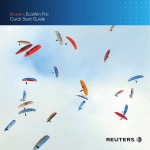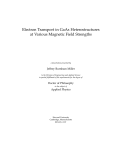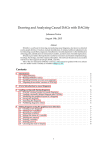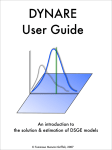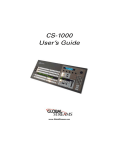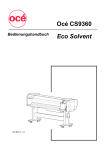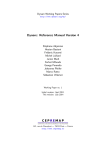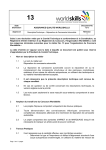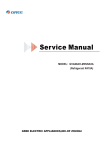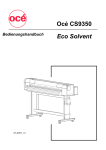Download brochure
Transcript
5$76 (CUV'CU[(NGZKDNGCPF4GNKCDNG6KOG5GTKGUCPF%TQUU5GEVKQPCN&CVC#PCN[UKU RATS provides all the basics, including linear and non-linear least squares, forecasting, and ARIMA models, but goes far beyond that with support for techniques like GMM, ARCH and GARCH, vector autoregressions (VARs), spectral analysis, state space models and DSGEs, and much more. It can handle time series of virtually any frequency, including daily and weekly, as well as panel data, and produces publication-quality graphs for printing or importing directly into word processors. Menu-driven “Wizards” provide a point-and-click interface for many common tasks, making RATS an ideal tool for new users and for educational settings. Meanwhile, the powerful commanddriven language at the heart of the program remains easy to learn and use for simple jobs, while also allowing users to automate complex or repetitive tasks and even write sophisticated menu- and dialog-driven end-user applications. RATS is available for Windows, Macintosh, UNIX, with complete compatibility across platforms. 6JG4#65XKPVGTHCEG*GTGVJGUGSWGPEGQHEQOOCPFUCRRGCTKPQPGVGZVYKPFQYYKVJVJGQWVRWVFKTGEVGFVQCPQVJGTYKPFQY 6JKUOCMGUKVGCU[VQUCXGEQOOCPFUCUCEQORNGVGRTQITCOYJKEJ[QWECPTGTWPNCVGTYKVJCEQWRNGQHOQWUGENKEMU#NUQ XKUKDNGCTGCTGRQTVYKPFQYUJQYKPIVJGQWVRWVHTQOC$QZ,GPMKPUGUVKOCVKQPCITCRJYKPFQYCPFCNQQMCVVJGYK\CTFUQP VJG6KOG5GTKGUOGPW /CLQT+ORTQXGOGPVU5KPEG8GTUKQP+PENWFG (QT/QTG+PHQTOCVKQPQTVQ2NCEGCP1TFGT ❒ Revised and expanded manuals, with all-new Introduction. RATS is available directly from Estima, and from resellers around ❒ Much faster computation speeds. Complex estimation programs may run up to two times faster than before. ❒ Significant extensions to state space and DSGE capabilities. the world. We offer single-user, multi-user and network licenses, as well as several options for using RATS in instructional settings, including discounts for full-time students. ❒ Reads data from Excel® 2007, Stata®, Matlab®, Eviews®. For more information, please visit our web site at: ❒ Census Bureau X12-ARIMA seasonal adjustment (Pro version). ZZZHVWLPDFRP ❒ Enhanced reporting features for viewing, saving, and exporting results. Can now export in TeX format. or contact us by phone, fax, mail, or email: ❒ More point-and-click Wizards. ❒ Dozens of new built-in functions. ❒ Graphics: Now generates box plots. More control over graph labeling, window titles, background color. ❒ Expanded View menu & toolbar icons for quick data analysis. ❒ New options for initial conditions on non-linear estimation. 7ROOIUHH *HQHUDO )D[ (PDLO ²² ²² VDOHV#HVWLPDFRP (VWLPD 6KHUPDQ$YH6XLWH (YDQVWRQ,/86$ 4#658GTUKQP(GCVWTGU Statistical Methods 'UVKOCVKQP6GEJPKSWGU ❒ Multiple regressions including stepwise ❒ Regression with autoregressive errors ❒ Heteroscedasticity/serial-correlation correction, including Newey-West ❒ Non-linear least squares ❒ Two-stage least squares for linear, nonlinear, & autocorrelated models ❒ Seemingly unrelated regressions and three-stage least squares ❒ Non-linear systems estimation ❒ Generalized Method of Moments ❒ Maximum likelihood estimation ❒ Constrained optimization ❒ Extensive built-in hypothesis testing, with procedures for a huge variety of unit-root, stability, and other tests ❒ Limited and discrete dependent variable models: logit, probit, censored/ truncated data (Tobit), count models ❒ Panel data support, including fixed and random effects estimators ❒ Non-parametric regressions ❒ Kernel density estimation ❒ Robust estimation ❒ Recursive least squares ❒ State-space models, including Kalman filtering and smoothing, simulations, and optimal control models ❒ DSGE models ❒ Neural network models ❒ Linear and quadratic programming 6KOG5GTKGU2TQEGFWTGU ❒ Easy to specify lags and leads for timeseries model estimation and analysis ❒ ARIMA and ARMAX models including multiplicative seasonal models; support for arbitrary lag structures ❒ Transfer function/intervention models ❒ Error correction models ❒ Kalman filter ❒ Spectral analysis (QTGECUVKPI ❒ ❒ ❒ ❒ ❒ Time series models Regression models Exponential smoothing Static or dynamic forecasts Simultaneous equation models (unlimited number of equations) ❒ Simulations with random or usersupplied shocks ❒ Forecast performance statistics, including Theil U statistics 8GEVQT#WVQTGITGUUKQPU 8#4U ❒ Unmatched support for VAR models ❒ Error Correction models ❒ Structural VARs. Choice of factorizations, including estimation of a factor matrix from a covariance matrix model ❒ Impulse responses, with Monte Carlo and Importance Sampling techniques for standard error bands. ❒ Forecasting ❒ Variance decomposition ❒ Historical decomposition ❒ Extensive hypothesis testing tools ❒ CATS 2.0 add-on provides industryleading cointegration analysis #4%*CPF)#4%*/QFGNU ❒ Univariate and multivariate, including BEKK, diagonal, CC, DCC, and VECH multivariate models ❒ Support for GARCH-in-mean models ❒ Additional exogenous variables in mean and/or variance equations ❒ Normal, t and GED distributions ❒ Exponential and Asymmetric models ❒ Robust standard errors Working With Data &CVC'PVT[ ❒ Menu-driven Data Wizards for reading in data ❒ Reads and writes Excel files, text files, EViews®, Stata®, and other formats ❒ Pro version supports SQL/ODBC ❒ On-screen data viewer and editor, with point-and-click graphing and statistics tools ❒ Can handle virtually any data frequency, including daily, weekly, intra-day, and panel data ❒ Can automatically convert data to different frequencies ❒ RATS data file format is fast and easy, supports all frequencies, and allows you to store series of different frequencies on the same file &CVC6TCPUHQTOCVKQPU ❒ Flexible transformations with algebraic formulas ❒ Easy to create trend series, seasonal, and time period dummies ❒ Extensive filtering operations, including Hodrick-Prescott, Henderson, Spencer, and custom filters ❒ Supports regular, seasonal, and fractional differencing )TCRJKEU ❒ ❒ ❒ ❒ ❒ High-quality time series graphics High-resolution X-Y scatter plots Dual-scale graphs Contour graphs Copy-and-paste graphs into other applications ❒ Export graphs to many formats, including PostScript and Windows Metafile ❒ User can customize attributes such as line thickness, colors and grayscale levels, and fill patterns Interface +PVGTCEVKXG/QFG'PXKTQPOGPV ❒ Text-editor based ❒ Point-and-click “wizards” for many tasks, greatly enhancing ease-of-use ❒ Saved programs can be re-run with just a few mouse clicks ❒ Designed so that you can reproduce results, output, and graphs easily and accurately—a critical but often overlooked requirement for producing reliable, publication-quality results ❒ True multiple window support. Simultaneously view your input commands and output, spreadsheet-style “report” windows, graphs, and more 2TQITCOOCDKNKV[ ❒ Extensive looping capabilities and support for applying operations to lists of variables make it possible to automate many repetitive tasks ❒ You can write procedures, which can perform complex tasks with a single instruction, and write your own callable functions. ❒ A library of procedures written by RATS users from around the world is available free of charge on our web site ❒ A variety of interface-related instructions allow you to create your own drop-down menus, custom dialog boxes, and more RATS Professional The Professional versions of RATS add the following features not found in the Standard version: ❒ 64-bit version (Windows, UNIX/Linux) ❒ ODBC/SQL database support ❒ Census Bureau X12 seasonal adjustment routine ❒ Support for FAME data files (for Windows and UNIX/LINUX) ❒ Support for CRSP and FRED databases Free Technical Support, No Required Maintenance Fees Supported Platforms Estima supplies expert technical support at no additional charge for as long as you own the software. Most questions are answered within one day. Users can also participate in web and email discussion forums with RATS users from around the world. And your license to use RATS will never expire—there are never any required maintenance or licensing fees to continue using the software. 4#65HQT9KPFQYU WinRATS runs on Windows 2000, XP, Vista, and Windows 7. Pro versions includes 64-bit version. Requires a Pentium or better processor, a hard drive with at least 90Mb free, and a CD Rom drive. 4#65HQT/CEKPVQUJ Flexible Update Policies Minor updates are often made available as free downloads, while more significant updates are offered at very reasonable prices—typically no more than 10% to 15% of the original purchase price. Updates are always optional. For users who want to stay up to date automatically, we also offer Update Subscription programs, which make it easy to budget software purchases and provide you with all updates shipped to you on CD as soon as they are released. MacRATS is a “Universal” application and runs on any Intel or PowerPC-based Mac, running OS X 10.4 or later. It requires a hard drive with at least 90Mb free, and a CD Rom drive. 4#65HQT70+:CPF.KPWZ RATS is available for almost all UNIX and Linux systems, and now includes the same interactive-mode environment previously available only for Windows and Macintosh. The Linux and UNIX versions require a hard drive with at least 90Mb free, and a CD Rom drive. The Motif X11 windowing libraries are required for interactive mode use. The UNIX version requires that you have a C compiler to compile the source code. Pricing Prices for single-user licenses are shown below. We also offer multi-user licenses, discounts on additional single-user licenses, 6JG$QZ,GPMKPU#4+/#9K\CTFRTQXKFGUCPGCU[YC[VQGUVKOCVG#4+/#CPF#4/#:OQFGNUKPENWFKPIOQFGNUYKVJVTCPUHGT and several pricing options for classroom and HWPEVKQPQTKPVGTXGPVKQPVGTOU educational settings. Please contact Estima for details on any of these. 1.50 1.25 1.00 2TQFWEV 2TKEG WinRATS WinRATS Professional MacRATS MacRATS Professional Linux RATS (executable) UNIX/Linux RATS (with source) UNIX/Linux RATS Pro $500 $650 $500 $650 $600 $700 $850 7RFCVG5WDUETKRVKQP2TKEGU 0.75 0.50 1770 1780 1790 1800 ARCH6 1810 1820 EGARCH11 1830 1840 1850 1860 GARCH11 #UCORNGVKOGUGTKGUITCRJ*GTGYGʼnXGWUGFVJGITCRJKEUUV[NGUJGGVHGCVWTGKP4#65VQUGNGEVVJKEMGTNKPGUKPUJCFGUQH ITC[VQTGRTGUGPVVJGVJTGGUGTKGU$GECWUGVJGUGTKGUETQUUGCEJQVJGTUQHTGSWGPVN[VJGFCUJRCVVGTPUVJCVCTGVJGUVCPFCTF HQTDNCEMCPFYJKVGNKPGUYQWNFPʼnVNQQMCUIQQF9GʼnXGWUGFCPQVJGTQRVKQPVQRNCEGCMG[CVVJGDQVVQOQHVJGITCRJ For single-user licenses, an Update Subscription provides the user with all updates through and including Version 8, shipped on CD automatically. 2TQFWEVHQT5WDUETKRVKQP 2TKEG WinRATS, MacRATS WinRATS Pro, MacRATS Pro Linux RATS (executable) UNIX/Linux RATS (with source) UNIX/Linux RATS Pro $150 $175 $175 $200 $225 %#65%QKPVGITCVKQP#PCN[UKU2TQEGFWTG CATS (Cointegration Analysis of Time Series) is a sophisticated set of RATS procedures which implement the popular Johansen and Juselius cointegration analysis techniques. Version 2.0 was written by Jonathan Dennis, Katarina Juselius, Soren Johansen, and Henrik Hansen of the University of Copenhagen, and is distributed and supported by Estima. CATS is almost entirely a menu and dialog-driven procedure. You use standard RATS instructions to define the frequency, read in data, and do any necessary transformations. You then “source” in and execute the CATS procedures. From there, the rest of the analysis is done by selecting operations from the CATS pull-down menus, and entering information in pop-up dialog boxes. The Johansen–Juselius approach to cointegration is based on the errorcorrection form of a Gaussian vector autoregression. In particular, they analyze the decomposition of the matrix of error-correction coefficients Π into αβ'. The I(1) procedure supports partial systems, and makes it easy to specify weakly exogenous variables. You can also include dummy variables, or stationary dummy-type variables. To help you choose a model, CATS provides eigenvalues and trace test statistics for reduced rank (as well as 90% critical values if requested) and unrestricted estimates of α, β, and Π. You can check the model by calculating multivariate test statistics for residual autocorrelation, normality, and ARCH. Version 2 even provides an automated model selection routine. Additional features include: • Auxiliary procedures for multivariate tests of long-run exclusion, weak exogeneity and stationarity, and for calculating eigenvalues and trace statistics for five different hypotheses. • Ability to set and reset the rank of Π throughout the analysis, and a variety of tests to help you determine the “correct” rank order. • Graphical analysis tools, including plots of the β-vectors to check stationarity, and of residuals to locate possible problems with the Gaussian assumption, plus correlograms and autocorrelograms. • Descriptive statistics include: residual correlation matrices, the short-run parameters and associated t-values, estimates of the C-matrix (with asymptotic t-values) in the common trends representation, and the long-run covariance matrix. • Structural tests, including non-identifying restrictions on β, identifying restrictions on β, and weak-exogeneity hypotheses on α. • Supports recursive cointegration analysis, with tests for the constancy of the eigenvalues, stability of the estimated cointegration space and the estimated parameters, and the adequacy of the predictions from the model. The CATS package includes the CATS procedures on diskette, a 200-page user’s manual, and sample data and program files. The cost of a single copy of CATS is $175. The price for fulltime students is $125 (verification of student status is required). Site license prices are also available. CATS requires Version 6.2 or later of RATS, and is available for Windows, Macintosh, UNIX, and Linux. Please contact us if you have any questions about CATS or RATS. Also available: “The Cointegrated VAR Model: Methodology and Applications”, by Katarina Juselius. Written in conjunction with the development of CATS 2.0, this book provides a comprehensive look at both the theory and practice of cointegration analysis. It is highly recommended for anyone using CATS. 1PNKPG%QWTUGUCPF4GUQWTEGU Over the past few years, we have provided several popular online courses focused on particular topics in econometrics. These courses are delivered via the discussion forum on our website, and include 3') handbooks, example programs, and procedures specific to the course, along with interactive discussions on the lessons and related topics. Most courses last about two months, although we continue to field questions from course participants indefinitely. 5VCVG5RCEGCPF&5)'/QFGNU Upcoming Courses We do recommend that anyone purchasing the course materials also have a copy of the Durbin and Koopman book, which is available for purchase through Estima. The example programs require version 7.0 or later of 5$76. 2CPGNCPF)TQWRGF&CVC Our next web course will deal with Panel and Grouped Data, and will run from January 26 to March 8 of 2012. This will be based largely on Baltagi’s Econometrics of Panel Data, 4th edition. We added quite a few new capabilities to RATS Version 8.1 for handling panel and grouped data and this course will go over them carefully. Among the topics will be organizing data, handling balanced vs unbalanced (or generally grouped) data, panel data transformations, fixed and random effects issues with dynamic models (lagged dependent variables and panel VAR’s), unit roots and cointegration, and fixed and random effects in non-linear models like probits. Materials From Previous Courses The following sets of course materials, developed from our webbased, are now available on CD or by email for $50 per course. Each package includes the 3') handbook containing the lecture materials, as well as all of the example programs, data sets, and 5$76 procedures used in the course. Please see www.estima.com/courses.shtml for information on any current courses, or to order any of these materials via our website. $C[GUKCP'EQPQOGVTKEU The course wookbork is based upon the content of the RATS ecourse on Bayesian Econometrics, offered in April-May 2009. It covers most of the most important methods now used in Bayesian analysis in econometrics, including Gibbs sampling, MetropolisHastings and importance sampling. The applications are to a broad range of topics, include time series, cross-section and panel data. It assumes that the user is comfortable with such basic instructions as &20387(, ',63/$<, *5$3+, 6&$77(5 and /,15(*, and can use simple programming techniques such as '2 loops. In each chapter, there is a Tips and Tricks section which covers in greater detail any functions or instructions that might be unfamiliar. The presentation is based largely on Gary Koop’s Bayesian Econometrics (Koop 2003). We’ve added to that in several areas, with a chapter on vector autoregressions, and examples from the literature for panel, cross-sectional data and state-space models. In most cases, we’ve included much of the statistical derivations from the book, presented in a way to highlight the calculations as they are done with RATS, so even those without the book can benefit. The “State Space” part of this course, which ran in SeptemberOctober 2009, is based largely on Durbin and Koopman’s Time Series Analysis by State Space Methods book, supplemented by material from Harvey’s Forecasting, Structural Time Series Models and the Kalman Filter, and from West and Harrison’s Bayesian Forecasting and Dynamic Models. Roughly two-thirds of the course is devoted to State Space models, with the remainder focusing on '6*( models. 5VTWEVWTCN$TGCMUCPF5YKVEJKPI/QFGNU This course, which ran from October 2010 through early 2011, deals with a range of topics including outlier detection, intervention modeling in various models, tests for structural breaks and threshold effects, estimation of threshold and smooth transition models and endogenous Markov switching models. It covers both maximum likelihood and Bayesian estimation techniques. 8#4/QFGNU The course covers identifying and estimating VAR models, computing impulse responses and variance decompositions, historical decomposition and counterfactual simulations, structural and semistructural 9$5s, and sign restrictions. The course was originally presented in October-November 2009. The Vector Autoregression (VAR) was introduced to the economics literature in the famous paper “Macroeconomics and Reality” (Sims 1980b). Since then it, and its close relatives, have become the standard for analyzing multiple time series. Even when more complicated and tightly parameterized models are used, it’s the stylized facts gleaned from VAR analysis that they are expected to explain. In this course, we examine techniques that use “flat priors”; that is, the techniques designed to elicit information from the data without the use of informative Bayesian priors. Strongly informative priors (such as the so-called Minnesota prior) are widely used for building forecasting models, but they tend to improve forecasts by shutting down much of the cross-variable interaction. The techniques we examine are designed primarily to analyze precisely that type of interaction. 6JG4#65(QTWO In addition to hosting the online courses described above, the RATS software forum available at www.estima.com/forum provides a convenient venue for RATS users to discuss topics in econometrics, share rats programs and procedures with other users, and ask questions about using the software. Participation is free for all licensed users of the software.











